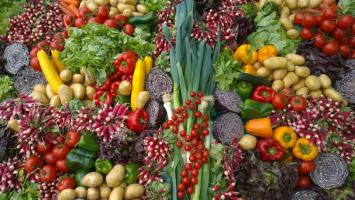
DIET & LIFESTYLE
DISCOVER HOW TO HEAL
Written by John Immel, IntroductionAcid reflux is often regarded as a minor annoyance, with approximately 20-30% of Americans experiencing symptoms on a weekly basis. To Ayurveda, these symptoms are a sign of a deeper imbalance, which, if left untreated will progress and fester in the digestive tract, causing bigger problems down the road.Ayurveda sees acid reflux as a symptom of several possibly deeper imbalances in the body. The easy way to remedy acid reflux might be to pop an antacid as needed, but often this merely masks the symptoms. Why not break the pill popping habit and find the real cause of your acid reflux? Did you know that treatments to neutralize stomach acid can actually lead to more acid reflux in the long run? Determining the root cause is essential when it comes to acid reflux. Ayurveda strongly encourages a preventative approach. Be proactive about any symptoms of indigestion you have, so you can maintain your vitality and well being for years to come. Resolving an issue in its early stages can save a great deal of discomfort and complications further down the line. The phrase, "A stitch in time saves nine," is especially true for digestive tract disorders like acid reflux. Most people assume acid reflux is caused by excess acid secretions, or hyperacidity. While a hot, burning sensation is the outcome of acid reflux, hyperacidity is actually not the most common cause in Ayurveda. This article will summarize the most common types of acid reflux, so you can determine what type is bothering you. What Type of Reflux is Bothering You?HypoacidityAs mentioned previously, it is a common misconception that acid reflux means you have too much stomach acid. More commonly, acid reflux is a sign of too little acid. The deficiency of acid causes food to sit too long in the stomach, causing the acid to regurgitate. Suspect hypoacidity if food seems to sit stagnant in the stomach after you eat, and if your appetite has become weaker. Also, suspect hypoacidity if you feel fatigued or sluggish after eating. Burping or any kind of bloating in the upper GI tract on a regular basis is also an indicator, particularly if you had an easy to digest meal.In hypoacidity, it is recommended to avoid all difficult to digest foods as much as possible, including, beans, peanuts, wheat, cheese, and milk. Adopting a diet of easy to digest foods, like soups, stews, and broths that have all been cooked for a long time is recommended for hypoacidity. Common kitchen herbs and spices, like black pepper and fresh ginger, can stimulate digestion and the secretion of gastric juices. Fennel seeds are a particularly good, mild digestive that is appropriate in cases of acid reflux. Ayurvedic herbal formulas such as hingvastak churna and trikatu stimulate acid secretions in hypoacidity. Another simple, but important, technique to improve hypoacidity is to keep hydrated. When dehydrated, your body produces less acid. Cold foods and drinks also slow down digestive functioning (agni) and the secretion of digestive juices. If you are dehydrated and your tongue is regularly dry, sip warm water until the tongue and palate stay moist. This indicates sufficient hydration for acid production. Avoid all cold or raw foods in hypoacidity, and instead focus on warm, well cooked foods. Overwhelmed StomachWhen the stomach is loaded with heavy foods, digestion becomes an arduous task. Similar to hypoacidity, a heavy feeling can occur in the stomach with burping after eating. This burping can propel food, and stomach acids, back up the esophagus causing acid reflux. You may experience acid reflux up to two or three hours after eating in cases of an overwhelmed stomach, as food continues to churn in the upper GI tract. An overwhelmed stomach can also cause excess gas production and lead to bloating and distention in the upper digestive tract.If you experience reflux as a result of an overwhelmed stomach, you might notice a thick, white coating on the tongue, mucus in the sinuses, coughing up phlegm, and have a tendency to gain weight easily. This type of reflux is generally aggravated by eating heavy, difficult to digest foods, particularly when eaten late at night. Foods like wheat, dairy, red meat, and refined sugar, burden digestion and can create excess mucus in the stomach. Mucus directly counteracts the action of acid, slowing down digestion. In fact, the purpose of mucus is to protect the lining of the stomach from the harmful acid, but too much can lead to an overwhelmed stomach. The first step to remedy this cause of acid reflux is to eliminate the heavy, difficult to digest foods. It is especially important to reduce large quantities of processed food, particularly in the evening, as this will certainly overwhelm the stomach and cause indigestion. If there is obstructive mucus in the stomach, lungs, or nasal passages, cardamom is considered the number one spice for clearing mucus in Ayurveda. Bitter orange peel also clears stomach stagnation and increases metabolism. GastritisGastritis is inflammation of the stomach lining. Symptoms can include abdominal pain or tenderness, generally in the upper-central or upper-left part of the abdomen. This may also be teamed with nausea, vomiting, or a burning pain in upper GI tract. This gastric inflammation is most commonly caused by a bacterial infection, known as H. pylori. Regular use of certain types of medication and drinking alcohol excessively can also cause gastritis.Over time, the chronic inflammation of the mucous membrane of the stomach contributes to the death of acid producing cells, known as atrophic gastritis. Loss of gastric glandular cells and reduced acid production can cause hypoacidity, described above. If the cause of gastritis is an infection, medical advice should be sought as antibiotics may be required. Then, reduce inflammatory conditions in the stomach by focusing on light, easy to digest foods. Nourishing meals like chicken soup, bone broth, or the Ayurvedic classic called kitchari, are all very easy on the stomach and reduce strain on an inflamed digestive tract. These easy to digest foods reduce the burden on digestive organs and use less energy in comparison to the heavy, difficult to digest foods, like peanuts, beans, and raw foods. It is essential to avoid stimulating substances that provoke inflammation with gastritis, such as bell peppers, cayenne pepper, alcohol, nicotine, carbonated beverages, and caffeine. Bitter herbs, like neem, and alteratives, like manjistha, can help by cleansing the blood and reducing inflammation. Cooling drinks, such as pomegranate, cranberry, and aloe vera juice, also help soothe stomach inflammation. Slimy and demulcent foods like okra, and herbs such as marshmallow root and licorice root, have a soothing, coating effect that reduces inflammation. amalaki may be used to clear inflammation. HyperacidityHyperacidity is the cause of acid reflux that is most commonly discussed, but it is actually more rare from an Ayurvedic standpoint. Hyperacidity is a Pitta disorder that is caused by intense emotions, high stress work environment, and a Pitta provoking diet that includes foods such as red meat, spicy curries, and alcohol. If you have hyperacidity, you may tend to have a ravenous appetite, strong pulse, a red tip on the tongue, and quick transit time of food through the digestive tract.In hyperacidity, preventing further excessive acid secretions is key. This means avoiding pungent and spicy foods and replacing them with heavier foods that reduce acid production, like wheat, avocados, and tapioca pudding. Also, avoid over stimulating the blood and circulation by reducing intense exercise, particularly something demanding and heating like hot yoga. Cranberry and pomegranate are both astringent and cooling. They soothe and tighten the digestive tract, reducing excess acid secretions. Herbs like amalaki, neem, licorice root, and aloe vera, are all useful for taming excessive acid secretions and balancing Pitta dosha. Avipattikar churna is one of the most commonly used formulas to promote post-meal esophageal comfort and regulate normal acidity levels in the intestines and stomach. In some cases, ending a meal with a small amount of sweet taste can help regulate acid secretions. Sweet foods do not include processed candy, but instead are naturally sweet like basmati rice, sweet potato, or almonds. Hiatal HerniaA hiatal hernia occurs when an organ, usually the upper part of the stomach, protrudes through the esophageal opening in the diaphragm, known as the hiatus. A hiatal hernia can compromise the lower esophageal sphincter (LES), which prevents acid from backing up out of the stomach and into the esophagus. When the LES is weakened, food and stomach acids can travel back through the valve and into the esophagus more easily. A hiatal hernia should be examined and treated under the care of a doctor, as it may require surgery in serious cases. There are, however, some things you can do that may reduce this cause of acid reflux.Good posture increases the tone and strength of digestive organs and reduces the likelihood of the stomach being pushed through the hiatus. Regular yoga and working at a standing desk are some techniques that can be practiced daily to improve posture. Smoking and aromatic herbs, such as cardamom and peppermint, should be avoided in this scenario as they cause the LES to relax and may worsen the acid reflux. Sleep on an incline, so that acid doesn't regurgitate during the night, preferably using a wedge pillow. In some cases, an abdominal self-massage can help redirect the affected part of the stomach back down into the abdominal cavity. It is best to check with your medical care provider first, and avoid massage if there is pain in the area. A chiropractor can also perform and help teach the correct technique. To practice this massage, slide your fingers a few inches across the bottom of the left rib cage. This will bring you to the point where the esophagus meets the stomach. Exhale so the stomach can relax, and start to gently exert some pressure with your fingertips in this area. If it feels comfortable, push your fingers slightly up and under the rib cage. Take a deep breath in and feel your lungs and ribcage expand. At the same time, draw your fingers downwards, pulling the stomach away from the diaphragm. On the exhale, reposition your fingers and exert either more or less pressure as needed. Repeat this breath cycle for several minutes. SummaryWhen you experience the burning sensations of acid reflux, you might assume too much stomach acid is the cause of your discomfort. You can see this in cartoons as firemen try to extinguish the raging flames coming from a person's belly. However, excessive acid production is actually rarely the the root cause of reflux. As this article has detailed, too little acid, or hypoacidity, is a far more common cause.You may be surprised to find that many cases of acid reflux are resolved by actually increasing acid production with digestive stimulants like hingvastak churna, and clearing excessive mucus that is blocking acid with aromatics such as cardamom. A lack of sufficient acids and too much mucus causes food to sit undigested in the stomach. This stagnation leads to both food and acids backing up through the esophagus. While excess heat is not the most common cause of acid reflux, it can still play a role. In inflammatory conditions such as gastritis, easy to digest meals and anti-inflammatory herbs, like amalaki and licorice root, can help soothe an irritated and inflamed stomach lining. In less common cases where acids are in fact too high, spicy and stimulating foods are best avoided, and cooling remedies like pomegranate and avipattikar churna can be used to reduce excess acid secretions. By understanding the main types of acid reflux and their causes, you can determine what type is bothering you. Instead of reaching for an antacid everytime you experience reflux, you can get to the root cause of your reflux to experience lasting relief and vitality. READ MORE ON THIS TOPIC
BROWSE SIMILAR ARTICLES BY TOPICHOTHot is identified by increased body temperature, metabolism, or inflammation.PUNGENTPungency is characterized by irritation, or sharp, spicy foods that irritate the mouth such as black pepper.SOURSour refers to anything fermented or acidic.FIREResembles fire (tejas) in quality - hot, sharp, penetrating, light, dry.ANTACIDHerbs that neutralize acidity in the gastrointestinal tract, the stomach in particular.

About the Author John Immel, the founder of Joyful Belly, teaches people how to have a healthy diet and lifestyle with Ayurveda biocharacteristics. His approach to Ayurveda is clinical, yet exudes an ease which many find enjoyable and insightful. John also directs Joyful Belly's School of Ayurveda, offering professional clinical training in Ayurveda for over 15 years.John's interest in Ayurveda and specialization in digestive tract pathology was inspired by a complex digestive disorder acquired from years of international travel, as well as public service work in South Asia. John's commitment to the detailed study of digestive disorders reflects his zeal to get down to the roots of the problem. His hope and belief in the capacity of each & every client to improve their quality of life is nothing short of a personal passion. John's creativity in the kitchen and delight in cooking for others comes from his family oriented upbringing. In addition to his certification in Ayurveda, John holds a bachelor's degree in mathematics from Harvard University. John enjoys sharing Ayurveda within the context of his Catholic roots, and finds Ayurveda gives him an opportunity to participate in the healing mission of the Church. Jesus expressed God's love by feeding and healing the sick. That kindness is the fundamental ministry of Ayurveda as well. Outside of work, John enjoys spending time with his wife and 7 kids, and pursuing his love of theology, philosophy, and language. STUDY AYURVEDA
Questions, Comments & Impressions of 'what type of acid reflux do you have?'?Is there something else you'd like to know about 'what type of acid reflux do you have?'?     (5.00 out of 5 stars) 1 rating, 101 likes (5.00 out of 5 stars) 1 rating, 101 likes     Sign in to review this article Sign in to review this article
i have very bad acid refuc problam even i have a burning in my stomeverything come to my mouth i try other to did not worki do not know what to do
If these recommendations are not improving your acid reflux, we recommend scheduling a consultation with an Ayurvedic practitioner.
|
Join Joyful Belly.
Want our top Ayurvedic recipes and health tips?Subscribe to our free newsletter!

 SAVE ARTICLE
SAVE ARTICLE

 On MeWe
On MeWe On Pinterest
On Pinterest On Facebook
On Facebook On Twitter
On Twitter On WhatsApp
On WhatsApp On Email
On Email


